Broken Bar M Ranch is the family ranching operation of Jeremy and Gail Martin along with children Chase, Regan, and Kaitlin. Jeremy grew up near Lexington, NE on a small commercial cattle and purebred swine operation. Gail wa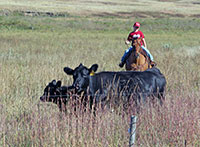 s raised on a commercial cattle and farming operation near Guide Rock, NE. After meeting at college as UNL Animal Science students and later being married, we began building our own herd of registered Angus and SimAngus composite cattle. Over the last ten years the cowherd has grown to about 300 mother cows. s raised on a commercial cattle and farming operation near Guide Rock, NE. After meeting at college as UNL Animal Science students and later being married, we began building our own herd of registered Angus and SimAngus composite cattle. Over the last ten years the cowherd has grown to about 300 mother cows.
Broken Bar M Ranch is only part of our involvement in the beef industry. Today, Jeremy spends most of his time as a consulting nutritionist with Great Plains Livestock Consulting, Inc. (www.GPLC-Inc.com). In 2011 we entered into a partnership in 4+ Feeders near Lexington, NE and Gail spends part of her time keeping books for the feedlot (https://www.facebook.com/4PlusFeeders). She is also licensed in real estate sales with Agri-Affiliates (http://www.agriaffiliates.com), although she has not had much time to focus on real estate yet.
 We have demanded from the beginning that our cows be problem-free. We believe more in corrective culling than corrective mating. Our cows summer on grass (some Sandhills, some hard ground), winter on corn stalks, and calve in the Platte River bottom. At calving time, our cows are expected to calve unassisted with strong maternal instinct and outstanding udder quality. We tag and weigh calves at birth, and do not tolerate disposition problems. From a feeding standpoint, we treat our cows like we would if they were commercial cows; no corn, no silage, no tubs, no lick tanks, and no excuses – grazed forage, mineral, and hay when necessary. We feed as little harvested hay and supplements as possible. Depending on hay quality, we We have demanded from the beginning that our cows be problem-free. We believe more in corrective culling than corrective mating. Our cows summer on grass (some Sandhills, some hard ground), winter on corn stalks, and calve in the Platte River bottom. At calving time, our cows are expected to calve unassisted with strong maternal instinct and outstanding udder quality. We tag and weigh calves at birth, and do not tolerate disposition problems. From a feeding standpoint, we treat our cows like we would if they were commercial cows; no corn, no silage, no tubs, no lick tanks, and no excuses – grazed forage, mineral, and hay when necessary. We feed as little harvested hay and supplements as possible. Depending on hay quality, we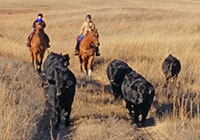 ather, and forage availability, we sometimes supplement our first-calf heifers with 2-3 lbs per day of DDG between calving and summer pasture. ather, and forage availability, we sometimes supplement our first-calf heifers with 2-3 lbs per day of DDG between calving and summer pasture.
Our cows are synchronized and AIed in late June on pasture and then exposed to cleanup bulls for a total breeding season of 45 days. We strive to produce cows that will wean half of their own body weight in the fall. We keep track of our cull calves and some of our customers’ cattle through the feedlot. These cattle will grow quickly to their endpoint, grade, and harvest with more ribeye per 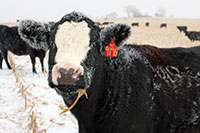 hundred weight than most. hundred weight than most.
So, what kind of cow works best for us? Moderate sized (not too tall OR too small), 1,175-1,350 pound cows that are deep-ribbed, productive, and capable of utilizing low quality forage. Our ideal cow is deep, thick, and puts on flesh easily in the fall after weaning, without being pampered. She is also feminine and perfect-uddered with extremely sound feet and legs. In order to consistently produce this kind of cow, we seek out and utilize the service of balanced trait bulls from genetics proven to work in systems like ours. These bulls need to be structurally sound, heavy muscled, easy keeping, highly fertile, and masculine. From these sires, selected daughters are most often mated to the same subsequent sire to produce consistency.
We believe in EPDs as tools for selection, but our ultimate goal is not for the most of everything, but for balance between maternal, performance, and carcass traits. We believe the only way to get the best of everything is to implement a planned crossbreeding 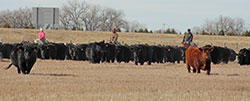 program to capture heterosis in the cowherd and feedlot-bound cattle. Recent MARC data clearly indicates the race for big numbers has resulted in larger mature size, to the extent that the average Angus cow is bigger than most continental breeds. Our Angus cattle are designed to be complementary to continental breeds. Our SimAngus cattle are designed for all of the above while maintaining maternal heterosis and providing a little more muscle and growth than their purebred Angus contemporaries. In all the cattle, we strive to avoid extremes and focus on balanced multi-trait selection. program to capture heterosis in the cowherd and feedlot-bound cattle. Recent MARC data clearly indicates the race for big numbers has resulted in larger mature size, to the extent that the average Angus cow is bigger than most continental breeds. Our Angus cattle are designed to be complementary to continental breeds. Our SimAngus cattle are designed for all of the above while maintaining maternal heterosis and providing a little more muscle and growth than their purebred Angus contemporaries. In all the cattle, we strive to avoid extremes and focus on balanced multi-trait selection.
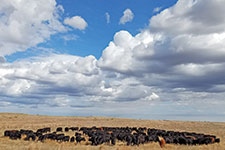 |
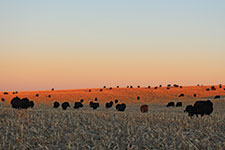 |
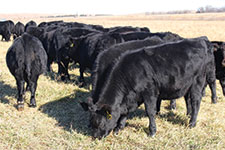 |
| The Broken Bar M April-May calving cows summer in the Sandhills, where we cake the pairs a couple times prior to fenceline weaning the calves in order to have the calves trained to come to the caker pickup after weaning. |
The cowherd spends Nov-late March grazing corn stalks. |
Calves eating DDG a few days after they were fencline weaned. |
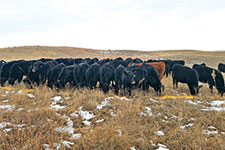 |
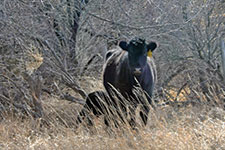 |
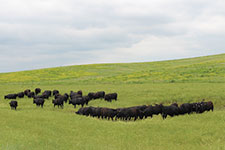 |
| Our weaned calves graze dormant pasture for about 30 days before moving to corn stalks. The heifer calves stay close to home and the bulls and steers winter on stalks close to the feedlot where they will run in a group of 300-400 total calves for the winter. |
The cows move to the river bottom between Hershey and Sutherland at the end of March to start calving. They graze dormant grass and are fed hay for as few days as we can each year. |
After a winter on stalks the bulls are always happy to get back to green grass. The 2 year olds stay on grass until mid-November when they return to stalks and supplemental feed prior to the sale. |
|
|